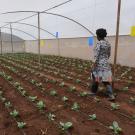Technologies for Horticultural Development fact sheet
Pest-exclusion nets protect crops to boost yield
Insect pests reduce crop yield by attacking crops and by transmitting diseases. Access to training and information on effective use of pesticides can be rare for many smallholder farmers. As a result, farmers often sell damaged produce or use high levels of pesticides, which can be dangerous to both farmers and consumers and can increase insect resistance to pesticides. Pest-exclusion nets can have a major impact in addressing many of these problems.
How the nets work
Pest-exclusion nets create a barrier that protects vegetables against pests and associated diseases. The nets are easy to use and can also serve as floating row covers to control temperature, light, relative humidity and soil moisture for plant production. The nets are low-cost and can be reused for 3–5 years. Pest-exclusion nets are made and marketed locally by mosquito net manufacturers.
Benefits
- Improve yields and vegetable quality
- Provide an inexpensive and safe method of managing insect pests
- Improve ambient growing conditions and water-use efficiency, enhancing yield and produce quality
- Reduce reliance on toxic and expensive pesticides that impact environmental and human health
- Increase market opportunities for domestically produced textiles
Basic costs
- Netting $60-99 per 150 m²
Costs are subject to local variation and depend on whether nets are impregnated with insecticide or not, lightweight or heavyweight.
What’s next? Scaling up
Education: Train farmers through field trials and demonstration plots.
Adoption: Highlight production and income gains. Increase product availability within the region.
Investment: Work with industry and entrepreneurs to promote the nets.

